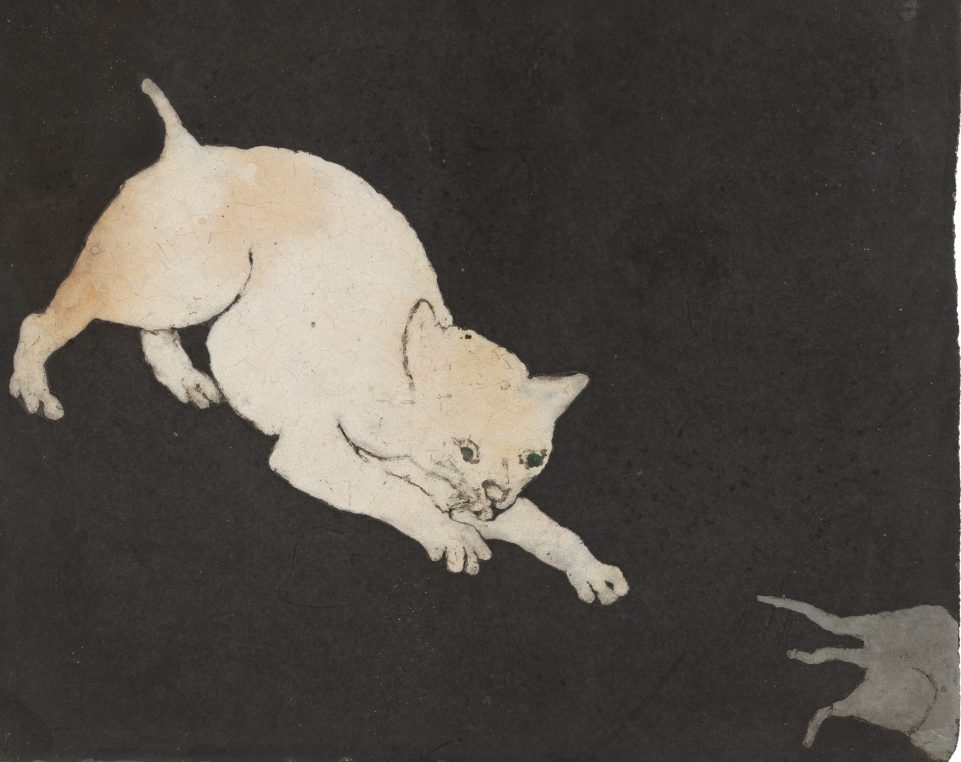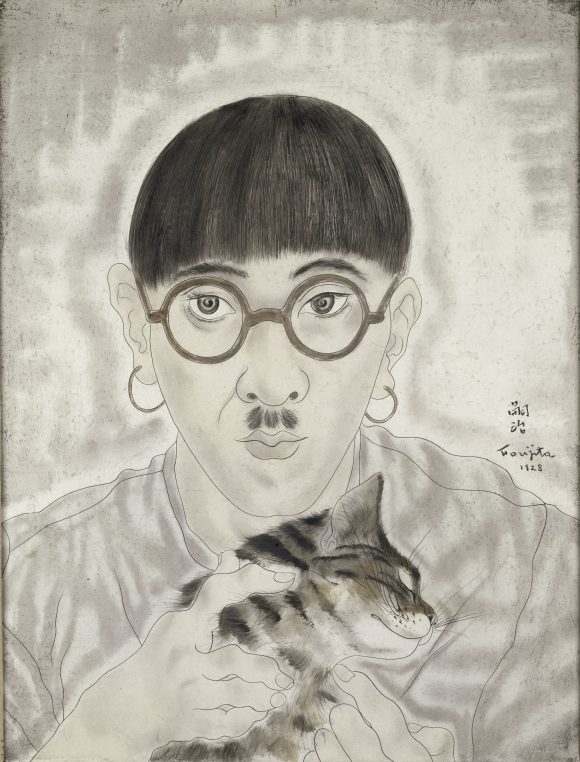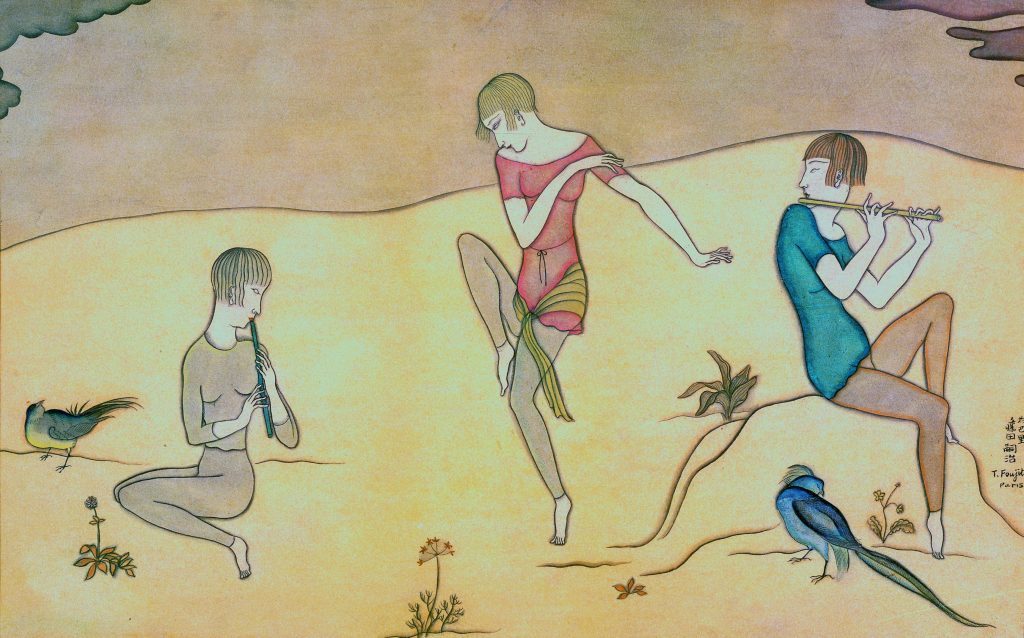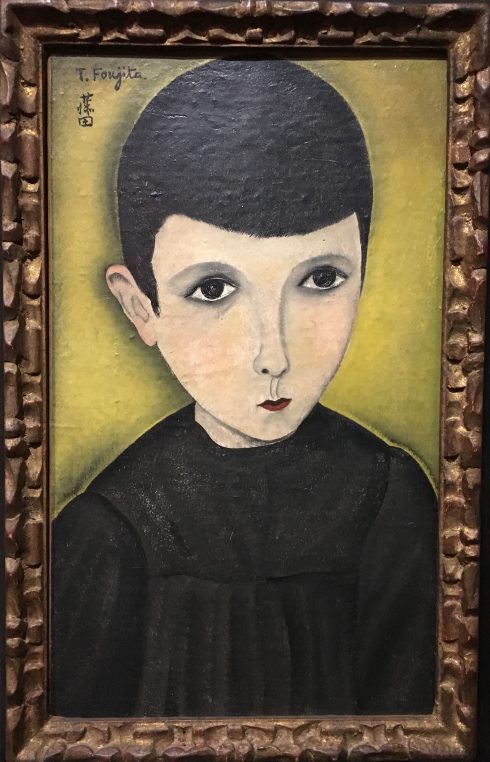The exhibition of Japanese artist Foujita (1886-1968) at Fondation Maillol is so varied that one could believe it refers to three different artists. From a very early age, Foujita became passionate about French art after seeing a painting by Monet. He was raised on the island of Kyushu where his father was a doctor in the Imperial army, and went to Tokyo to study art. But at 27, he moved to Paris, and immediately met Modigliani and Soutine. He became a French citizen in 1935.

Cat running after a mouse, Léonard Tsuguharu Foujita and Speranza Calo Seailles, 1925, private collection © Fondation Foujita
Foujita’s birth coincides in Japan with the Meiji era, when the whole country opened up to occidental influences. French Impressionists had access to Japanese etchings and included them in their style, and Foujita very soon started learning French.
When he lands in Paris in 1913 on the eve of the First World war, he finds an ebullient city where many International artists are already thriving. Picasso, Diego Rivera, Van Dongen among many others. He discovers Italian Primitives at the Louvre, and immediately falls in love with Montmartre and Montparnasse.
In 1918, he is invited to stay in Cagnes sur Mer by the art merchant Leopold Zborowski and he meets the aging Renoir. Modigliani and Soutine are part of the trip and they start exchanging ideas and influencing each other. Ten years later, photographer André Kertesz makes a series of fascinating portraits of him, which could be shot today, such is their modernity.
He meets Lucie Badou “Youki” a red headed beauty whom he will paint endlessly. For her 20 th birthday, he offers her a convertible car with a radiator cap, which is “Man with a broken nose”, a bronze by Rodin! “Youki” means snow in Japanese and the nickname comes from her very white skin. He films her and draws her over an dover again. He will leave Paris in 1931 and let her live with her other lover, poet Robert Desnos.
On the ground floor of Fondation Maillol, there are eight large gilt panels which were made in 1929 for Cercle de l’Union Interalliée in Paris. They represent hens and chickens, pheasants and cats and were commissioned from Foujita after he took part in the First Salon of Japanese artists at Garlerie de la Renaissance in Paris. He also painted panels for the Japanese House of Cité Universitaire and took part in a large show at Jeu de Paume. He then started traveling to Japan again and went on a tour to the United States.
He will be made a French citizen with his second wife in 1935. After travelling to French Indochina during the Second World war, he returns to France and befriends René Lalou, the president of Mumm champagne, who commissions a chapel from him in Reims after he converted to catholicism. It is extremely beautiful and worth the trip.

Léonard Tsuguharu Foujita, Portrait of the artist, 1928, Centre Pompidou – Musée national d’art moderne – Centre de création industrielle © Fondation Foujita
The exhibition designed by Hubert le Gall and curated by Sylvie Buisson owes a lot to Fondation Foujita which, I just learned, is part of Les Apprentis d’Auteuil, to whom Foujita has bequeathed all his artistic rights. (Fondation Maillol, until July 15)
Share this Post





4 Comments on “Foujita, the Japanese master who fell in love with Paris”
Thank you…I have long adored Foujita….lucky you to have seen the exhibition.. Katie
Bravo et merci pour cet article interéssant sur Foujita qui le met bien en lumière
et lui rend la notoriété qu’il mérite.
Thank you for sharing the talent of this remarkable japanese artist in your weekly morning call.
hello i saw the show in Paris because of this post. The show is really interesting- worth a trip and the lines…